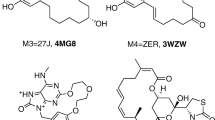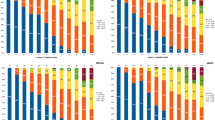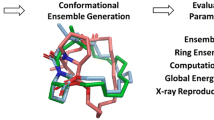Abstract
Macrocyclic compounds experience increasing interest in drug discovery. It is often thought that these large and chemically complex molecules provide promising candidates to address difficult targets and interfere with protein–protein interactions. From a computational viewpoint, these molecules are difficult to treat. For example, flexible docking of macrocyclic compounds is hindered by the limited ability of current docking approaches to optimize conformations of extended ring systems for pose prediction. Herein, we report predictions of bioactive conformations of macrocycles using conformational search and binding modes using docking. Conformational ensembles generated using specialized search technique of about 70 % of the tested macrocycles contained accurate bioactive conformations. However, these conformations were difficult to identify on the basis of conformational energies. Moreover, docking calculations with limited ligand flexibility starting from individual low energy conformations rarely yielded highly accurate binding modes. In about 40 % of the test cases, binding modes were approximated with reasonable accuracy. However, when conformational ensembles were subjected to rigid body docking, an increase in meaningful binding mode predictions to more than 50 % of the test cases was observed. Electrostatic effects did not contribute to these predictions in a positive or negative manner. Rather, achieving shape complementarity at macrocycle-target interfaces was a decisive factor. In summary, a combined computational protocol using pre-computed conformational ensembles of macrocycles as a starting point for docking shows promise in modeling binding modes of macrocyclic compounds.





Similar content being viewed by others
References
Yudin AK (2014) Macrocycles: lessons from the distant past, recent developments, and future directions. Chem Sci 6:30–49
Driggers EM, Hale SP, Lee J, Terrett NK (2008) The exploration of macrocycles for drug discovery: an underexploited structural class. Nat Rev Drug Discov 7:608–624
Yu X, Sun D (2013) Macrocyclic drugs and synthetic methodologies toward macrocycles. Molecules 18:6230–6268
Villar EA, Beglov D, Chennamadhavuni S, Porco JA Jr, Kozakov D, Vajda S, Whitty A (2014) How proteins bind macrocycles. Nat Chem Biol 10:723–731
Gao M, Cheng K, Yin H (2015) Targeting protein–protein interfaces using macrocyclic peptides. Biopolymers 104:310–316
Wessjohann LA, Ruijter E, Garcia-Rivera D, Brandt W (2005) What can a chemist learn from nature’s macrocycles? A brief, conceptual view. Mol Divers 9:171–186
Nicklaus MC, Wang S, Driscoll JS, Milne GWA (1995) Conformational changes of small molecules binding to proteins. Bioorg Med Chem 3:411–428
Beck JG, Chatterjee J, Laufer B, Kiran MU, Frank AO, Neubauer S, Ovadia O, Greenberg S, Gilon C, Hoffman A, Kessler H (2012) Intestinal permeability of cyclic peptides: common key backbone motifs identified. J Am Chem Soc 134:12125–12133
Witek J, Keller BG, Blatter M, Meissner A, Wagner T, Riniker S (2016) Kinetic models of cyclosporin a in polar and apolar environments reveal multiple congruent conformational states. J Chem Inf Model 56:1547–1562
Kajitani K, Fujihashi M, Kobayashi Y, Shimizu S, Tsujimoto Y, Miki K (2008) Crystal structure of human cyclophilin D in complex with its inhibitor, cyclosporin A at 0.96-Å resolution. Proteins 70:1635–1639
Jez JM, Chen JC-H, Rastelli G, Stroud RM, Santi DV (2003) Crystal structure and molecular modeling of 17-DMAG in complex with human Hsp90. Chem Biol 10:361–368
Boström J, Norrby PO, Liljefors T (1998) Conformational energy penalties of protein-bound ligands. J Comput Aided Mol Des 12:383–396
Tirado-Rives J, Jorgensen WL (2006) Contribution of conformer focusing to the uncertainty in predicting free energies for protein-ligand binding. J Med Chem 49:5880–5884
Foloppe N, Chen I-J (2009) Conformational sampling and energetics of drug-like molecules. Curr Med Chem 16:3381–3413
Foloppe N, Chen I-J (2016) Towards understanding the unbound state of drug compounds: implications for the intramolecular reorganization energy upon binding. Bioorg Med Chem 24:2159–2189
Allen SE, Dokholyan NV, Bowers AA (2016) Dynamic docking of conformationally constrained macrocycles: methods and applications. ACS Chem Biol 11:10–24
Sefler AM, Lauri G, Bartlett PA (1996) A convenient method for determining cyclic peptide conformation from 1D 1H-NMR information. Int J Pept Protein Res 48:129–138
De Julián-Ortiz JV, Verdejo B, Polo V, Besalú E, García-España E (2016) Molecular rearrangement of an aza-scorpiand macrocycle induced by pH: a computational study. Int J Mol Sci 17:1131
Papoyan G, Gu K-J, Wiorkiewicz-Kuczera J, Kuczera K, Bowman-James K (1996) Molecular dynamics simulations of nitrate complexes with polyammonium macrocycles: insight on phosphoryl transfer catalysis. J Am Chem Soc 118:1354–1364
Wu EL, Mei Y, Han K, Zhang JZH (2007) Quantum and molecular dynamics study for binding of macrocyclic inhibitors to human α-thrombin. Biophys J 92:4244–4253
Watts KS, Dalal P, Tebben AJ, Cheney DL, Shelley JC (2014) Macrocycle conformational sampling with macromodel. J Chem Inf Model 54:2680–2696
Labute P (2010) LowModeMD—implicit low-mode velocity filtering applied to conformational search of macrocycles and protein loops. J Chem Inf Model 50:792–800
Chen I-J, Foloppe N (2013) Tackling the conformational sampling of larger flexible compounds and macrocycles in pharmacology and drug discovery. Bioorg Med Chem 21:7898–7920
Berman HM, Westbrook J, Feng Z, Gilliland G, Bhat TN, Weissig H, Shindyalov IN, Bourne PE (2000) The protein data bank. Nucl Acids Res 28:235–242
Chemical Computing Group, Inc. Molecular Operating Environment, version 2014.09
Oprea TI (2000) Property distribution of drug-related chemical databases. J Comput Aided Mol Des 14:251–264
Durrant JD, McCammon JA (2011) BINANA: a novel algorithm for ligand-binding characterization. J Mol Graph Model 29:888–893
Morris GM, Huey R, Lindstrom W, Sanner MF, Belew RK, Goodsell DS, Olson AJ (2009) AutoDock4 and AutoDockTools4: automated docking with selective receptor flexibility. J Comput Chem 30:2785–2791
Open Eye Scientific Software, Inc. OEChem TK, version 2015.10.1
Jain AN (2008) Bias, reporting, and sharing: computational evaluations of docking methods. J Comput Aided Mol Des 22:201–212
Watts KS, Dalal P, Murphy RB, Sherman W, Friesner RA, Shelley JC (2010) ConfGen: a conformational search method for efficient generation of bioactive conformers. J Chem Inf Model 50:534–546
Forli S, Botta M (2007) Lennard–Jones potential and dummy atom settings to overcome the AUTODOCK limitation in treating flexible ring systems. J Chem Inf Model 47:1481–1492
Acknowledgments
We thank OpenEye Scientific Software for a free academic license.
Author information
Authors and Affiliations
Corresponding author
Electronic supplementary material
Below is the link to the electronic supplementary material.
Rights and permissions
About this article
Cite this article
Anighoro, A., de la Vega de León, A. & Bajorath, J. Predicting bioactive conformations and binding modes of macrocycles. J Comput Aided Mol Des 30, 841–849 (2016). https://doi.org/10.1007/s10822-016-9973-5
Received:
Accepted:
Published:
Issue Date:
DOI: https://doi.org/10.1007/s10822-016-9973-5




